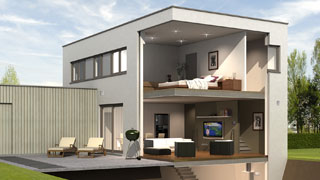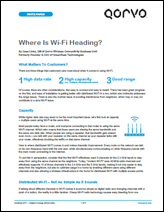Back to the Future: Wireless Predictions from 15 Years Ago … and Where It Actually Went
August 16, 2018
 Drop
yourself in a time machine and transport yourself way back, all the way to
2002-2003. Remember the gadgets you had around you? You probably were still
holding onto your home phone and might have been lucky to have the top-selling
cell phone at the time — the Nokia 6610. You probably had a desktop computer, not a
laptop, and Wi-Fi was only starting to become more common. Netflix only had
mail-service DVDs. Facebook didn’t even exist yet, and remember
Myspace?!
Drop
yourself in a time machine and transport yourself way back, all the way to
2002-2003. Remember the gadgets you had around you? You probably were still
holding onto your home phone and might have been lucky to have the top-selling
cell phone at the time — the Nokia 6610. You probably had a desktop computer, not a
laptop, and Wi-Fi was only starting to become more common. Netflix only had
mail-service DVDs. Facebook didn’t even exist yet, and remember
Myspace?!
This was the landscape in which Cees Links, now considered a Wi-Fi pioneer, made some bold predictions about the future in his 160-page e-book, The Spirit of Wi-Fi. In this book, he explained how the first wireless LANs were created and how a very special meeting with Steve Jobs changed the face of wireless communications in the late 1990s.
Predicting the future can be fun…but tricky. I sat down with Cees to
see how his predictions matched up with reality — and where he thinks
wireless technology might go from here.
Smart everything
Q: You predicted that business people would have four gadgets to help them in their day: a computer notebook with Wi-Fi and Bluetooth® technology, a palmtop with Bluetooth, a cell phone with GPRS and Bluetooth, and a wireless headset with Bluetooth. This is remarkably close to what happened. What was your biggest takeaway?
 A: Yeah — I was pretty close if you replace the
palmtop with a tablet. Now you have a laptop to do real work, a tablet for
convenient reading and checking the internet on the road, and a smartphone
when really nonstationary. What amazes me the most is the demise of phone
communication. Or better, phone communication has been replaced for a large
portion by the successors of text messaging, the “chat”
applications (WeChat, WhatsApp, Line, etc.). The other thing that happened,
quite unexpectedly with these apps, is the “group chat,”
particularly for younger generations. It almost has become “I chat, and
therefore I exist,” to paraphrase an old saying: “I think, and
therefore I exist.”
A: Yeah — I was pretty close if you replace the
palmtop with a tablet. Now you have a laptop to do real work, a tablet for
convenient reading and checking the internet on the road, and a smartphone
when really nonstationary. What amazes me the most is the demise of phone
communication. Or better, phone communication has been replaced for a large
portion by the successors of text messaging, the “chat”
applications (WeChat, WhatsApp, Line, etc.). The other thing that happened,
quite unexpectedly with these apps, is the “group chat,”
particularly for younger generations. It almost has become “I chat, and
therefore I exist,” to paraphrase an old saying: “I think, and
therefore I exist.”
The other remarkable thing was that in those years, we spoke a lot about videophone conversations becoming commonplace and our concern about the amount of bandwidth they would require. Interestingly, videophone is (almost) free with chat communications, but “selfies” and “instagrams” are way more popular. A good conversation face-to-face or over the telephone has an alternative now, with burps of one-way communications back and forth.
Q: You predicted that the number of devices would be reduced by merging the functionality of a cell phone and palmtop. What new technologies surprised you the most?
A: Yes, indeed the palmtop and the phone integrated and the tablet emerged — though many people may not know that the tablet, an Apple Newton, originally launched in the mid-1990s. But it never really caught on. It was too early, and the proper data-communication standards and infrastructure didn’t exist yet. Also, the MCUs (the brains of the computer) weren’t powerful enough. This required essentially another decade of development.
What I had really missed was the need for a tablet — and frankly, initially I was skeptical. Now I see the tablet slowly starting to take over from the laptop, in the same way that chatting is taking over from emailing. So, who knows? The days of the laptop may be numbered.
Q: “Let’s not forget the watch,” you said back in 2002, questioning if it could play a larger role in the world of technological devices beyond mere accessory or jewelry. Clearly, smart watches like the Apple Watch, Samsung watches and Fitbit devices have brought this reality to life. Do you think a smart watch will continue to be hype or that new functionality will emerge? Do you own one?
A: I’m surprised I mentioned that a watch could be more than jewelry! But indeed, the thought of making the watch more useful than for merely tracking date and time has always lingered, and it still does. I think the watch industry so far has successfully kept the electronic watch at bay for two reasons: first, a watch is still a piece of jewelry, and second, the battery life is still low.
Fitness trackers are experiencing the same thing. They’re
encroaching on the watch industry — but my expectation is that they
won’t be successful in destabilizing it, much like smart watches. I
wear a Fitbit, but one that is purely sensing, as a simple bracelet. I love
my jewelry watch…but wearing two watches is a little pathetic. I
would get totally annoyed if they weren’t indicating exactly the same
time!

The future of Wi-Fi
Q. Wi-Fi was in the early stages of adoption when you wrote this book. At the time, you described it as a rich standard that would be with us for the coming decades and provide a solid basis for newer capabilities. Wi‑Fi 6 (802.11ax) is expected next year. What do you think will come next, or what challenges will have to be solved in the future?
A. Wi-Fi (IEEE 802.11) is indeed still with us and going strong — no end-of-life in sight! From 802.11b to a, g, n, ac, ad and now Wi‑Fi 6 (802.11ax), high-performance wireless technologies have been evolving from the beginning of this century. Essentially, there have always been two major drivers: good coverage in your whole house (or office, etc.) and faster speed. There have been other underlying drivers, like reducing heat consumption (to avoid your smartphone from melting) and integrating functions while reducing the price. At this moment, the need for higher data rates, bandwidth and capacity will continue, without compromising the coverage. This is in line with the fact that video continues to be more and more important. Why should it take hours to download the latest series before going on a trip?
Recently, I wrote a white paper, Wi‑Fi 6 (802.11ax):
What’s It All About?, and indeed, higher speed, capacity and
bandwidth are the key ingredients to success today. Everybody is connected
on the same channel at the same time, and we always want more speed. There
will be no rest for service providers!
New smart home use cases?
Q. Let’s talk about the smart home. There are multiple use cases that could be created to make the home smarter, like smart lighting, home security or lifestyle monitoring. You mentioned in your book that household applications will grow quickly, once the infrastructure is in place. Is this the case today?
A. Interestingly, the idea of low-power Wi-Fi was floating around a lot, and what we see today is that both Zigbee (which is essentially low-power Wi‑Fi) and Bluetooth Low Energy have established themselves — although frankly, it took longer than I expected. I think it took longer because the value proposition of Zigbee and Bluetooth Low Energy isn’t so much higher data rate, but longer battery life — which doesn’t tie into a strong application like video.
Normally, a company begins with the business case for a product, which drives the application space. But with the smart home, it’s the other way around — the application is driving the business case. This means it’s taken longer to establish the value of the smart home — but it’s getting there, slowly but surely.
 The challenge is still the
infrastructure. Each application almost needs its own gateway connected to the
router to have lights, sensors or smart meters connected to the internet,
making implementation unnecessarily expensive. One of the larger steps forward
are routers and set-top boxes with Zigbee and Bluetooth Low Energy integrated, and that’s
what the industry is working on now.
The challenge is still the
infrastructure. Each application almost needs its own gateway connected to the
router to have lights, sensors or smart meters connected to the internet,
making implementation unnecessarily expensive. One of the larger steps forward
are routers and set-top boxes with Zigbee and Bluetooth Low Energy integrated, and that’s
what the industry is working on now.
I think the future of the smart home is distributed Wi-Fi,
with a pod in every room serving as an access point. With Wi‑Fi 6 (802.11ax)
and distributed Wi-Fi, consumers will have Wi-Fi everywhere in their home or
office. Each pod can also carry wireless communication technologies, like
Zigbee or Bluetooth. It will also allow command through voice activation and
enable talking to the internet as a common feature in every room. This new
infrastructure will help develop multiple use cases in the smart home —
all using the same infrastructure. Learn more in
our distributed Wi-Fi infographic.
Where will Wi-Fi go from here?
Q. To wrap up this interview, one thing is for sure — we’re excited to be a part of this technology evolution and help shape the future of Wi‑Fi. Where do you think we’ll stand in another 15 years?
A. There’s no shortage of demand for higher data rates and longer battery life, so developments in this area will continue. Nowadays, I have to charge my laptop and my phone every day, which is a nuisance that I grudgingly accept. Data rates continue to be a bottleneck, but that probably needs to be extended toward system-level performance. My Wi-Fi is way faster than the cable internet link to my house, and sometimes sitting behind a very fast connection, with its instant reaction on mouse clicks and no waiting, makes it clear that the industry still needs to improve a lot in basic needs.
But even more exciting is the interaction between wireless connectivity and artificial intelligence. Being able to exchange data all the time — from sensors to work data, or exploring thoughts and ideas for leisure, or finding opportunities for relaxation and enjoyment — when it’s connected to proper guidance based from someone who “knows you” and can help, wouldn’t that be a dream we wish could come true?
Breakthroughs in human life have always come from technology inventions beyond imagination — cranes to help us lift things, wheels to move us faster than we can walk, writing to help us remember more than we can keep in our head, printing to share ideas wider and faster than we could imagine. And today, connectivity allows us to live in a healthier, more comfortable and more eco-friendly way — and to make better decisions, and make them faster.
A connected world is a better world. Here’s to the next 15 years of Wi-Fi — no doubt it’s a future of great possibility!
Have another topic that you would like Qorvo experts to cover? Email your suggestions to the Qorvo Blog team and it could be featured in an upcoming post. Please include your contact information in the body of the email.

